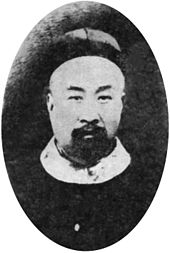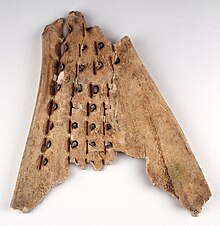Oracle bone
Oracle bones are pieces of ox scapula and turtle plastron which were used in pyromancy – a form of divination – during the Late Shang period (c. 1250 – c. 1050 BCE) in ancient China.[1] Diviners would submit questions to deities regarding weather, crop planting, the fortunes of members of the royal family, military endeavors, and similar topics.[3] Pyromancy with bones continued in China into the Zhou dynasty, but the questions and prognostications were increasingly written with brushes and cinnabar ink, which degraded over time.[18] In 1899, an antiques dealer from Shandong who was searching for Chinese bronzes in the area acquired a number of oracle bones from locals, and later sold several to Wang Yirong, the chancellor of the Imperial Academy in Beijing.[21] Decades of uncontrolled digs followed to fuel the antiques trade,[d] and many of these pieces eventually entered collections in Europe, the United States, Canada, and Japan.[16] Only a small number of dealers and collectors knew the location of the source of the oracle bones until they were found by Canadian missionary James Mellon Menzies, the first person to scientifically excavate, study, and decipher them.[24] The Chinese still acknowledge the pioneering contribution of Menzies as "the foremost western scholar of Yin-Shang culture and oracle bone inscriptions"[citation needed].[24][25][26] By the time of the establishment of the Institute of History and Philology by Fu Sinian at the Academia Sinica in 1928, the source of the oracle bones had been traced back to modern Xiaotun (小屯村) village at Anyang in Henan.Observing that the citation of these different works was becoming unwieldy, historians Hu Houxuan and Guo Moruo began an effort to comprehensively publish all bones discovered by the mid-1950s.[30] The vast majority of the inscribed oracle bones were found at the Yinxu site in modern Anyang and date to the reigns of the last nine Shang kings.[38] From this data, the Xia–Shang–Zhou Chronology Project, relying on the statement in the "Against Luxurious Ease" chapter of the Book of Documents that the reign of Wu Ding lasted 59 years, dated it from 1250 to 1192 BCE.[43] 26 oracle bones throughout Wu Ding's reign have been radiocarbon dated to 1254–1197 BCE (±10 years) with an estimated 80-90% probability of containing the true individual ages.[52] Neolithic diviners in China had long been heating the bones of deer, sheep, pigs, and cattle for similar purposes; evidence for this in Liaoning has been found dating to the late fourth millennium BCE.The divination charges were often directed at ancestors, whom the ancient Chinese revered and worshiped, as well as natural powers and Dì (帝), the highest god in the Shang society.Anything of concern to the royal house of Shang served as possible topics for charges, from illness, birth and death, to weather, warfare, agriculture, tribute and so on.[68] The use of heat to crack scapulae (pyro-scapulimancy) originated in ancient China, the earliest evidence of which extends back to the 4th millennium BCE with archaeological finds from Liaoning, though these were not inscribed.[53] The scapulae of cattle, sheep, pigs, and deer used in pyromancy have been found at neolithic archeological sites,[69] and the practice appears to have become quite common by the end of the third millennium BCE.[54] Ox scapulae and plastrons, both prepared for divination, were found at the Shang culture sites of Táixīcūn (台西村) in Hebei and Qiūwān (丘灣) in Jiangsu.[74][75] A turtle plastron bearing several short inscriptions was found at Daxinzhuang in Shandong on the floor of a semi-subterranean house dating from the Late Shang period.[76] Nearly 300 inscribed oracle bones (HB 1–290) were found in 1977 in two pits dug into a building foundation at Qijia, Fufeng County, Shaanxi, part of the Zhou ritual centre known as the Zhōuyuán.[77][78] The inscriptions are distinguished from those of Anyang in the way the bones and shells were prepared and used, the smallness of the characters, the presence of unique vocabulary, and the use of the phases of the moon as a dating device.However, evidence for the continued use of plastromancy exists for the Eastern Zhou, Han, Tang,[83] and Qing[84] dynasty periods, and Keightley mentions its use in Taiwan as late as 1972.





Shanghai MuseumChineseStandard MandarinHanyu PinyinWade–GilesRomanizationYue: CantoneseYale RomanizationJyutpingSouthern MinTâi-lôscapulaplastronpyromancydivinationLate ShangScapulimancyoracle bone scriptthermal expansionZhou dynastycinnabarChinese writingChinese charactersDoubting Antiquity SchoolOraculologyWang YirongHan dynastyAnyangdragon bonestraditional Chinese medicinePleistocenepoulticesShandongChinese bronzesImperial Academybronze inscriptionsBoxer RebellionTangyinLuo ZhenyucalquedJames Mellon MenziesJapanese invasion of ChinaFu SinianAcademia SinicafasciclesHu HouxuanGuo MoruoJiaguwen HejiWu DingDong ZuobinZu GengZu JiaLin XinKang DingWen Wu DingDi Xin60-day cyclebrancheslunar eclipsesXia–Shang–Zhou Chronology ProjectBook of DocumentsDavid KeightleyKen-ichi TakashimaplastronscarapacesLiaoningErligangZhengzhouXiao JiaHeavenly Stems and Earthly BranchesOld ChineseonomatopoeiaJiangsuErlitouDaxinzhuangFufeng CountyShaanxiDuke of ZhouTang dynastySpring and Autumn periodmilfoilI ChingEastern ZhouKau CimJiaobeiTung ShingFutomaniBamboo and wooden slipsNeolithic signs in ChinaPan GengXiao XinXiao Yihumerustalus boneChinese Academy of Social SciencesRites of ZhouFairbank, John KingKeightley, David N.Li, FengLi, XueqinRadiocarbonBibcodeQiu, XiguiJerry NormanShaughnessy, Edward L.Wilkinson, EndymionThe Globe and MailWorld Digital LibraryNational Library of ChinaMethods ofAiluromancyAlectryomancyAuguryMyomancyMyrmomancyOrnithomancyNggàmBibliomancyFalnamaRhapsodomancyVirgilScryingAspidomancyCatoptromancyCrystal gazingDowsing